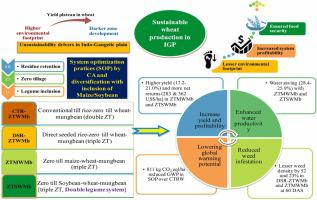当前位置:
X-MOL 学术
›
Eur. J. Agron.
›
论文详情
Our official English website, www.x-mol.net, welcomes your feedback! (Note: you will need to create a separate account there.)
On-farm evidence on breaking yield barriers through optimizing wheat cropping system in Indo Gangetic Plain
European Journal of Agronomy ( IF 4.5 ) Pub Date : 2024-07-01 , DOI: 10.1016/j.eja.2024.127256 Radheshyam , Shankar Lal Jat , M.L. Jat , C.M. Parihar , H.S. Jat , A.K. Singh , Deepak Bijarniya , Smruti Ranjan Padhan , Praveen V. Kadam , Manish Kumar
European Journal of Agronomy ( IF 4.5 ) Pub Date : 2024-07-01 , DOI: 10.1016/j.eja.2024.127256 Radheshyam , Shankar Lal Jat , M.L. Jat , C.M. Parihar , H.S. Jat , A.K. Singh , Deepak Bijarniya , Smruti Ranjan Padhan , Praveen V. Kadam , Manish Kumar

|
The wheat production in the food basket of South Asia has plateaued with threats of environmental sustainability and posing a serious challenge to future food security. For sustainable wheat production in conventional rice-wheat (CTRW) systems under changing climatic scenario, atwo-year on-farm study was conducted. We evaluated system optimization practices (SOP) of legume inclusion with CTR-zero-tillage (ZT) wheat-mungbean (CTR-ZTWMb) and direct seeded rice-ZT wheat-mungbean (DSR-ZTWMb) and triple ZT (raised bed) based futuristic systems of maize-wheat-mungbean (ZTMWMb) and soybean-wheat-mungbean (ZTSWMb). The global warming potential (GWP) of wheat production was significantly reduced by 811 kg CO eq/ha (783−861) in the SOP compared to CTRW. Moreover, the water usein wheat reduced by 85.9 and 85.2 ha-mm/ha in CTR-ZTWMb and DSR-ZTWMb with higher reduction in ZTMWMb and ZTSWMb by128.7 and 118.0 ha-mm/ha, respectively over CTRW. Similarly, the total weed density was reduced at 60 (39 and 52 %) and 90 (38 and 49 %) days after sowing with CTR-ZTWMb and DSR-ZTWMb over CTRW. However, the weed density reduction was lesser with ZTSWMb and ZTMWMb at 60 (3.0 and 23.6 %), and 90 (9.8 and 31.0 %) days after sowingcompared to the CTRW.The partial factor productivity (PFP) of NPK applied was 8.5–19.0 % higher under SOP over the CTRW. The use of non-renewable energy in wheat cultivation was reduced by 24.4–28.9 % with SOP over CTRW. The enhancement in wheat grain yield (7.4–11.8 %) and net returns (98–169 US$/ha) was also recorded with CTR-ZTWMb and DSR-ZTWMb and this gain in futuristic systems (ZTMWMb and ZTSWMb) was much higher in grain yield (17.2–21.0 %) as well as in net returns (283 and 362 US$/ha) over CTRW. The adoption of these SOPs on 1 million ha could produce 0.37–1.05 million t additional wheat over CTRW. The on-farm study evidenced thatwheat production with system optimization practices of legume inclusion and zero tillage are better alternatives to achieve higher productivity and profitability with a lesserenvironmental footprint in Indo-Gangetic Plains and similar agroecological regions.
中文翻译:

印度恒河平原通过优化小麦种植制度打破产量障碍的农场证据
南亚粮食篮子中的小麦产量已趋于稳定,环境可持续性受到威胁,并对未来粮食安全构成严重挑战。为了在不断变化的气候条件下传统稻麦(CTRW)系统中小麦的可持续生产,进行了为期两年的农场研究。我们评估了基于 CTR-零耕 (ZT) 小麦-绿豆 (CTR-ZTWMb) 和直播水稻-ZT 小麦-绿豆 (DSR-ZTWMb) 和三重 ZT(高床)的豆类纳入系统优化实践 (SOP)玉米-小麦-绿豆(ZTMWMb)和大豆-小麦-绿豆(ZTSWMb)的未来系统。与 CTRW 相比,SOP 中小麦生产的全球变暖潜势 (GWP) 显着降低了 811 kg CO eq/ha (783−861)。此外,CTR-ZTWMb和DSR-ZTWMb的小麦用水量减少了85.9和85.2公顷毫米/公顷,其中ZTMWMb和ZTSWMb比CTRW分别减少了128.7和118.0公顷毫米/公顷。同样,与 CTRW 相比,CTR-ZTWMb 和 DSR-ZTWMb 在播种后 60 天(39% 和 52%)和 90 天(38% 和 49%)时总杂草密度降低。然而,与 CTRW 相比,在播种后 60 天(3.0 和 23.6 %)和 90 天(9.8 和 31.0 %)时,ZTSWMb 和 ZTMWMb 杂草密度降低幅度较小。施用 NPK 的部分要素生产力 (PFP) 为 8.5–19.0 SOP 下的百分比比 CTRW 下的高。与 CTRW 相比,SOP 使小麦种植中的不可再生能源使用量减少了 24.4-28.9%。 CTR-ZTWMb 和 DSR-ZTWMb 还提高了小麦籽粒产量 (7.4–11.8%) 和净收益 (98–169 美元/公顷),并且未来系统(ZTMWMb 和 ZTSWMb)的这种收益要高得多与 CTRW 相比,粮食产量(17.2-21.0%)以及净回报(283 和 362 美元/公顷)。在 100 万公顷土地上采用这些 SOP 可以产生 0.37-1。比 CTRW 增加 500 万吨小麦。农场研究证明,在印度恒河平原和类似的农业生态地区,采用豆类纳入和零耕作系统优化实践的小麦生产是实现更高生产率和盈利能力、同时减少环境足迹的更好替代方案。
更新日期:2024-07-01
中文翻译:

印度恒河平原通过优化小麦种植制度打破产量障碍的农场证据
南亚粮食篮子中的小麦产量已趋于稳定,环境可持续性受到威胁,并对未来粮食安全构成严重挑战。为了在不断变化的气候条件下传统稻麦(CTRW)系统中小麦的可持续生产,进行了为期两年的农场研究。我们评估了基于 CTR-零耕 (ZT) 小麦-绿豆 (CTR-ZTWMb) 和直播水稻-ZT 小麦-绿豆 (DSR-ZTWMb) 和三重 ZT(高床)的豆类纳入系统优化实践 (SOP)玉米-小麦-绿豆(ZTMWMb)和大豆-小麦-绿豆(ZTSWMb)的未来系统。与 CTRW 相比,SOP 中小麦生产的全球变暖潜势 (GWP) 显着降低了 811 kg CO eq/ha (783−861)。此外,CTR-ZTWMb和DSR-ZTWMb的小麦用水量减少了85.9和85.2公顷毫米/公顷,其中ZTMWMb和ZTSWMb比CTRW分别减少了128.7和118.0公顷毫米/公顷。同样,与 CTRW 相比,CTR-ZTWMb 和 DSR-ZTWMb 在播种后 60 天(39% 和 52%)和 90 天(38% 和 49%)时总杂草密度降低。然而,与 CTRW 相比,在播种后 60 天(3.0 和 23.6 %)和 90 天(9.8 和 31.0 %)时,ZTSWMb 和 ZTMWMb 杂草密度降低幅度较小。施用 NPK 的部分要素生产力 (PFP) 为 8.5–19.0 SOP 下的百分比比 CTRW 下的高。与 CTRW 相比,SOP 使小麦种植中的不可再生能源使用量减少了 24.4-28.9%。 CTR-ZTWMb 和 DSR-ZTWMb 还提高了小麦籽粒产量 (7.4–11.8%) 和净收益 (98–169 美元/公顷),并且未来系统(ZTMWMb 和 ZTSWMb)的这种收益要高得多与 CTRW 相比,粮食产量(17.2-21.0%)以及净回报(283 和 362 美元/公顷)。在 100 万公顷土地上采用这些 SOP 可以产生 0.37-1。比 CTRW 增加 500 万吨小麦。农场研究证明,在印度恒河平原和类似的农业生态地区,采用豆类纳入和零耕作系统优化实践的小麦生产是实现更高生产率和盈利能力、同时减少环境足迹的更好替代方案。
















































 京公网安备 11010802027423号
京公网安备 11010802027423号